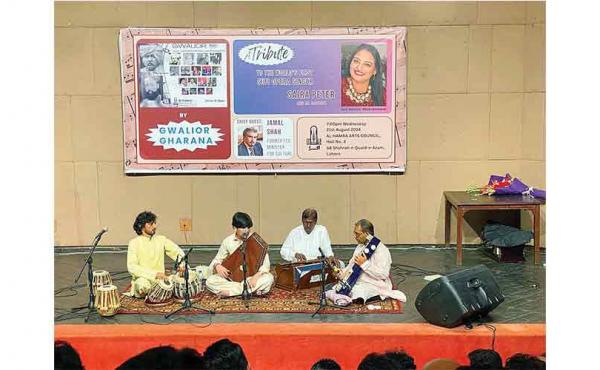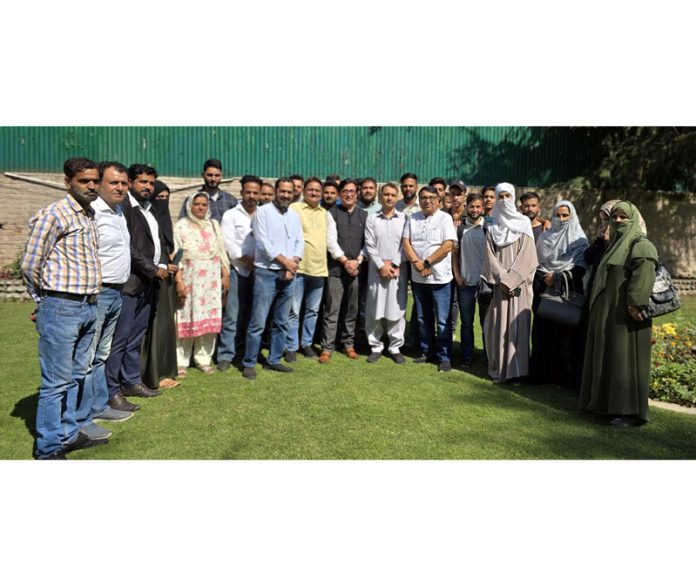S heema Kermani visited Lahore in May, soon after the elections, when things were feeling incredibly grim and stagnant. I had recently revived my practice after many years of hiatus and was fully experiencing the joy of remembering forgotten things and the sadness of skills and strings rusted over and stultified for years of disuse. Sheema was conducting workshops and giving talks during her visit.
I had her over for dinner at my house and attended her two-day Orissi workshop at The Colony, and was infused with motivation and inspired by her resilience. I asked her how she had managed to remain hopeful and persistent in bleak times, both as an activist and classical dancer (although she doesn’t see a difference between the two). She squeezed my shoulders and said, “People like us can never lose hope.

” Kirmani started the workshop by explaining to the students and The Colony dancers what a classical art is: “It’s an art perfected over generations — over hundreds, sometimes thousands, of years. There are times in history when it expands and branches out. Once in a while there is a bringing together.
The branches of Indian classical dance and music are like roots of the same tree. This is true of the classical arts all over the world: every generation adds their contributions and over time it becomes a classical art form.” It all came alive in my mind, the links in the chains, many lost and forgotten, many still in the process of erosion, leading back to the same source and reflecting the divine.
Her hands moved in the Bharatnatyam style showing the expansions and contractions over time as she moved into the practical lesson that had women half her age sweating and breathless in minutes. The classical arts are not easy to learn. They take years of relentless, and often thankless, dedication to master, if at all.
When it came to the practitioners of the Indian classical arts, their fate was decided by which side of the border they ended up on. I was at my friend Ashi’s (Ayesha Nadir Ali) house recently. Ashi had been a student of the late Ustad Hafiz Khan of the Talwandi , who died in relative obscurity and not-so-great financial circumstances, despite being one of the last remaining s.
Ashi is now an accomplished classical singer in her own right. She can sing almost anything on cue, from Sufi poets to classical s, pitch perfect and without accompaniment. She was on her way to Ustad Pervaiz Paras’s house to record his notes on two rare s for a series of books (two of which have already been published) on classical music, designed to make life easier for students and seekers.
She told me that Ustad Fateh Ali Khan, the flag-bearer of the Gwalior , was visiting Lahore along with some other musicians in the clan, and that they were doing a concert at Alhamra. She was going to take Paras there after the recording session, since he had been asked to speak on the history and influence of the Gwalior , whose ancestors were s to many other well-respected and s in the subcontinent. Eager to meet Ustad Fateh Ali Khan, and hoping for a chance to hear him sing live (given that you can’t find him on Spotify or YouTube), I asked Ashi if I could tag along.
“The Gwalior are so beautiful,” she said. At Paras ’s house, Ashi recorded Tahuria Malhaar and some other obscure s, the (notes) used and the (progression). As we drove on The Mall towards Alhamra, Paras was hit with a wave of nostalgia for when classical music was not so hard to find in Lahore.
He told us stories of GA Farooq, who was a dedicated patron of the arts and arranged public concerts regularly, despite being from a conservative Syed family. I was awed to hear that Pandit Jasraj had visited Lahore and Raza Kazam, another music connoisseur at the forefront of keeping the classical arts alive, had arranged a concert for him. Paras also showed us the basic structure of some es of the Gwalior .
He was looking forward to seeing Ustad Fateh Ali Khan, who he said had a heart condition, was 80 years old and was still singing. I I was surprised by Paras ’s encyclopaedic knowledge of the history, theory and practice of classical music. Ashi asked him if Ustad Fateh Ali Khan was going to perform.
He said, “Of course, he never leaves a without performing. Some other singers from the will perform, too. There’s a woman they say, a student of one of them, Saira Peter, I’ve never heard of her.
She’s going to perform in the beginning after Hanif on flute. She paid for the whole event and arranged for the house of Gwalior to come, so they have to indulge her. But it will probably be only 30 minutes.
” “Maybe she’s not so bad, Paras ,” I said, “let’s hear her out,” quite familiar with the inherent disdain that have for disciples who don’t come from musical families. The concert was supposed to start at 6 in the evening; we arrived an hour later. It started at 8pm.
The sound system was not working properly from the beginning and throughout the event. An old man shuffled in, leaning on a teenage boy holding a . He was tall and held a dignified posture with a strikingly straight neck, even if weakened by age and heart disease.
The hall was full. Everyone stood up as he made his way to a reserved seat in the front row. A few minutes later, Ustad Ghulam Ali Khan, one of the last great singers walked in, and the excitement in the audience was palpable.
He took a seat next to Ustad Fateh Ali Khan. It was apparent from the way they greeted each other that they were old friends. Ashi leaned in to me and said, “That boy is his youngest son.
He accompanies his father now, but the father can still sing which is a testament to the power of (practice).” Muhammad Hanif played a mesmerising rendition of Raag Multani on the flute, to the appreciation of both s in the front row. Before he began, he said what an honour it was to perform at a Gwalior concert and sought permission from both the s in the front row.
To the musicians in the audience, including accompanists, students and many accomplished performers, this was expected and customary. Then the TV cameras and B-list politicians walked in, and Saira Peter (who turned out to be the real ‘star’ of the show) took the stage, in a blindingly bedazzled cape. She introduced herself as the world’s first “Sufi Opera” singer, a term she has coined and copyrighted, so that no one else tries to call themselves that (no one else has ever tried to).
She said she had studied opera in London and only came here to perform. Peter was told by her (Roshan Abbas Khan of the Gwalior ), as Hanif took permission from the senior s to begin, that this was the way it was traditionally done. She paid no heed and turned the event into a self-funded, self-promotional situation, with reporters documenting the narrative she wanted them to spread.
She sang several , in exactly their original forms, without any variation to necessitate the invention of a new genre, and sang them rather badly. The audience, most of whom had probably never heard opera before, was awed and confused. The Gwalior is credited with the practice and promotion of in the subcontinent and particularly in the Punjab; their are unique, rare and not commonly documented.
Despite their matchless contributions, like Ustad Paras and many others who tried to make their fortunes in this country, they are struggling to survive, which leaves them vulnerable to exploitation, particularly at the hands of a certain class of young people less interested in investing hard work and time into the practice and more interested in making a name for themselves using their parents’ social connections. Many of the speakers at the event seemed heartened that someone was willing to promote this music on the international stage. S, but sadly, the Gwalior was barely represented.
Centuries of accumulated wisdom, passed down orally from master to disciple and an undeniable historical legacy aside, classical s tend to be simple people. They often lack formal education and can only promote themselves by performing. In the post-colonial sense, places like the NCA also do not provide consistent livelihoods to them anymore, valuing formal degrees over knowledge that cannot (often) be found in any book or anywhere else in the world.
After partition, PTV and Radio Pakistan were safe havens for these artists, but a lot of that space was lost in the Zia-era bans on music and subsequent waves of Islamisation and Talibanisation. O On stage there was a large picture of Saira Peter. I pointed out to Ashi that the sign next to it read “a tribute to Saira Peter by Gwalior ,” and not the other way around, as one would imagine.
She and Paras assumed that it was a misprint (naively; it was far too specific), because in their world such audacity was not heard of. As the evening wore on, I went out of the hall, smoking and gossiping with musicians outside and returned, really just waiting for Ustad Fateh Ali to take the stage. He never did.
Two and a half hours of hit-and-miss attempts at operatic styling, and a faulty, occasionally screeching sound system later, there was a strange ceremony involving Jamal Shah, the chief guest, a former politician. There is an unwritten law in modern Lahore that whenever the ‘chief guest’ is a political figure, there must be ceremonial exchanges of flowers, plaques . Tarannum Naz and others who had been celebrities in their eras, now aging, ailing and often needing assistance to walk, were hauled onto the stage, handed envelopes of cash in front of the cameras and nudged (not too subtly) to sing the praises of the woman of the hour.
Ustad Paras was called to the dais, where he went into some detail about the Gwalior , the city of Gwalior (from where Tansen hailed) and the notable s of the lineage. Ustad Fateh Ali Khan was called onto the stage, not to sing but to accept his (let’s not forget who paid for the event) and to present a bouquet of flowers to the chief guest, Jamal Shah, who didn’t know better than to take them. The lesser musicians had been lured in by the promise of free dinner.
As Peter, her guests and the TV cameras left for food, the Gwalior s started to perform. Most of the audience had left by then (the vast majority disappointed and shocked at what had transpired). Ustad Fateh Ali Khan’s youngest son, Izzat Fateh Ali, was a breath of fresh air; his voice still ripening yet technically more proficient than most of the adult performers — the heavyweight of a dying legacy on his young shoulders.
At 12:30 am, when the only people left were musicians who all knew each other, Ustad Fateh Ali Khan got up to leave. It had gotten too late and he was tired, and didn’t seem to fully grasp what had happened. Realising that I wasn’t going to hear him sing and thinking I may never get a chance to again, given his age and the state of his health, I went up to him and said that I only came because I wanted to see him perform live.
He patted me on the head and said, “ ”.



















